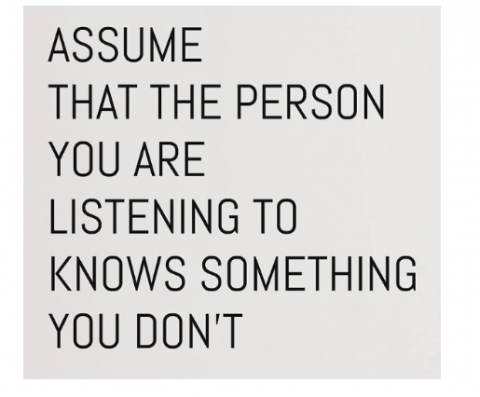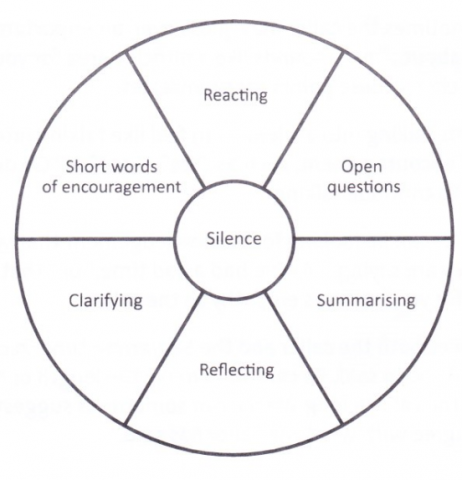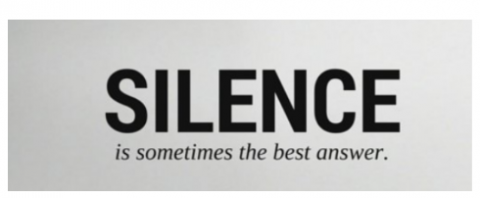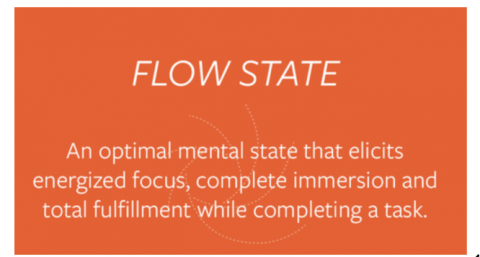In my experience, active listening is the most powerful tool we have to positively influence people. It has diverse applications from management to sales, coaching to counselling.
However, without practice, we tend to be quite poor at listening. This is just as true when we communicate online as it is face-to-face.
When people talk, listen completely. Most people never listen ~ Ernest Hemingway
With this in mind, I have detailed 5 active listening practices that are useful for becoming a better listener.
This article will take just over 5 minutes to read, so for the tl;dr generation (too long; didn’t read), I have summarised the 5 practices here:
- Assume the person you are listening to knows something you don’t
- Use the active listening techniques in conversations
- Mind the gap; leave a space after they finishing speaking
- Watching the breath
- Turn statements into questions
Practice 1: assume the person you are listening to knows something you don’t
Active listening makes us more influential leaders, more compassionate managers, and more persuasive salespeople. There are a myriad of reasons why listening well is so potent, but I feel the primary benefit is that it demonstrates you care about the other person. Nothing says I care more about myself more than you better than talking over them.
The first barrier we reach in becoming better influencers is our own ego. We think we know more than the person we are conversing with. The antidote for this? Assume the person you are listening to knows something you don’t.

When we assume they have a unique richness of experience and depth of knowledge, it moves us into a position where we take a genuine interest. This attentive, interested, and open state of mind is the prerequisite for active listening. (* the name of this practice is taken from a chapter title in the book “12 rules for life”)
Practice 2: use active listening techniques
There are actual techniques for active listening? I thought actual listening was just like hearing, but harder? This is what I used to think when I heard “active listening”. In fact, there are tried and tested techniques for active listening. An organisation that I volunteer at teaches these techniques using what they call the “listening wheel”.
The idea is that in coaching, sales, or supportive environments, we should be guiding the conversation using open questions and then utilising the elements detailed below to reflect, summarise, and clarify on what the person is saying.

How does this help us to influence?
- asking insightful, open questions helps us discover the needs of the person we are speaking with.
- through reflecting and clarifying, we take the time to uncover the detail – the hidden “why” behind the surface “what”.
- summarising what we have heard, ideally with more precision and insight than how the information was given to you, demonstrates you have really understood their needs.
In a sales environment, this is particularly powerful when preceded directly by your solution or pitch.
If I have been able to perfectly understand and summarise your exact problem, it follows that the solution I subsequently propose will likely be more appropriate than a solution proposed by a competitor who has not demonstrated such as an in-depth understanding. As anyone involved in sales pitches knows, say your piece and then be quiet. Silence is such a critical part of listening and persuasion it deserves its own practice.
Practice 3: mind the gap; leave a space after they finish speaking
On the above diagram, you will see silence sits at the centre. Becoming comfortable with silence is such a powerful technique that it is taught to detectives when teasing out confessions! The appropriate use of silence can help you close a contract, negotiate a pay rise, or encourage a friend to open up when struggling emotionally. This is because people find silence awkward and rush to fill the gap.

A golden rule for active listening, influence, and generally not being an egomaniac, is to not talk over people. The problem is that we think faster than we can speak. The brain can process 400 words per minute. In contrast, even the fastest speaker can only get out 125 words per minute.
This means that before the person has even finished speaking you have anticipated the end of their sentence, comprehended it, and related it to a relevant piece of one-upmanship which is now on the tip of your tongue! Unfortunately, we sometimes lack the restraint to hold off and inevitably blurt out our thoughts whilst they are still speaking! These interruptions are uncomfortably common and damage your ability to make a connection.
The solution requires more perseverance and patience in practice than it sounds in theory:
Leave a small gap between someone finishing what they are saying and before you start speaking

When I started to practice this I quickly found out that the other person hadn’t really finished speaking, they were just pausing for breath! It showed me just how keen I was to jump in with my own opinions, inevitably hijacking the flow of the conversation. Just witness how often this occurs in conversation and how obvious it is that we often care more about what we are waiting to say than what has just been said. So the practice is to mind the gap – to leave a second of silence after they have finished before you begin. But how do we do this when our mind is working overtime? If we think 4 times faster than we speak, how can we learn to be still?
Practice 4: watching the breath
Being calm, relaxed, and focused is the optimal state for listening. It is actually the optimal state for almost all performance related activities, which has led to the term “flow state” being coined.

One reason we interrupt others is that our minds are racing with ideas whilst we are being spoken to.
We are not listening, we are waiting for our turn to speak
To bring greater quality to our interactions, it helps to quieten the mind, become present, and enter a flow state. The practice for this is simple but requires repetition – learn to focus your attention on the sensation of breathing. This is done either by feeling your abdomen rising and falling, or the sensation of air as it enters and exits your nostrils. When you focus on your breathing, your chattering mind is distracted and quietens. This means you can be present in your interactions and truly listen.
Practice 5: turning statements into questions
As a rule of thumb, I try to go into interactions aiming to speak significantly less than the other person. Whilst I often break this rule, I know a meeting has been successful if I speak far less than 50% of the time. One tool that helps with this is to ask questions rather than make statements. This helps to open up the conversation. By telling people rather than asking, we erode trust and confidence. By making statements of fact rather than opening up debate, we dampen our individual and collective curiosity.
For example, instead of providing her own analysis of a mistake, a leader can ask “what can we do better next time?”. Instead of going for his preferred method for closing a deal, a salesperson can ask “how would you like me to follow up?”. A master of this method is the radio-host James O’Brien. Love him or hate him, James makes an art of using probing questions to make him point for him. In this interaction, James is debating “Peter” on using “bikini girls” to promote F1 Racing.

Like a talk-show Socrates, James guided the caller to his own conclusions with probing questions, rather making statements that risk alienating his listeners. We can all become better listeners, communicators, and leaders by reframing our statements into questions.
How to actively listen: a summary
In my opinion, the most valuable skill for positively influencing others is active listening. Whilst simple in theory, listening is a skill which is difficult to master and requires practice. However, it is worth the effort. Active listening provides us with a versatile tool kit we can use to coach, persuade, and be better able to support those around us.
The 5 practices I would recommend are:
- Assume the person you are listening to knows something you don’t
- Use the active listening techniques in conversations
- Mind the gap; leave a space after they finishing speaking
- Watching the breath
- Turn statements into questions
If you want to speak to someone who will listen to your digital marketing requirements, feel free to get in touch with one of our experts!






